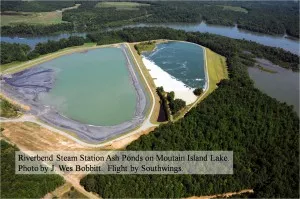
- Two of the Charlotte-area's unlined, hazardous coal ash ponds.
It's been nearly two and a half years since the coal ash spill in Tennessee that got everyone's attention, nearly a year and a half since the U.S. Environmental Protection Agency's first promised deadline for reform and one year since the agency offered two regulatory options.
In that time, we've filled you in on the threat to Charlotte's drinking water (read "Is coal ash poisoning Charlotte-area drinking water?") and our city played host to one of the EPA's public coal ash hearings where local citizens spent the day asking for the government to protect them from the coal industry and local coal industry employees spent the same day pleading for light reforms.
We've had doctors plead for their patient's health and neighbors tell us about their coal ash-covered gardens and their family's problems with cancer. We've had religious leaders beg regulators to look out for the country's citizens and environmental groups point out how dangerous it is to pour arsenic — just one of the ingredients in coal ash — into our drinking water, which happens at the rate of about two pounds per day in Charlotte's Mountain Island Lake -- our drinking water reservoir.
And, still there are no reforms ... only proposals, which mean nothing.
The EPA's proposal, first released on May 4, 2010, offered two options: Regulate coal ash as a "special," or hazardous, waste — or not.
Now, you'd think, after more than 30 years of investigating the stuff, they'd know how to regulate it by now — especially since many of the ingredients in coal ash are already regulated as hazardous and scientists have determined the stuff is radioactive.
But, there are politics and corporate profits to consider ... despite the EPA's own estimate that its more stringent regulation will save billions in health-related costs, as we reported last September:
While the EPA estimates it will cost, nationally, $20.3 billion per year to regulate coal ash as a hazardous waste and $8.1 billion to regulate it as a non-hazardous waste, they also estimate the regulation will save $290 billion in health care costs annually.
Here's the Center for Progressive Reform on the coal ash regulation proposal anniversary:
Today marks the one-year anniversary since the EPA released its proposed rule for controlling the disposal of coal ash, a toxic byproduct of burning coal to produce energy that contains harmful chemicals like arsenic, lead, and mercury. That announcement came fully six months after the EPA had sent an initial strong proposal (October, 2009) to the Office of Information and Regulatory Affairs; OIRA then held the initiative, beyond its authorized time limit, conducting literally several dozen meetings, mostly with industry lobbyists, on the issue. When OIRA released the edited version and the EPA announced the proposal in May of 2010, CPR president Rena Steinzor lamented that the proposal—actually, a co-proposal of two strikingly different approaches to regulating the waste—seemed calculated more to “postpone[e] any definitive action for at least six months and, far more likely, a year or more” than to quickly and effectively resolve this looming threat to public safety and the environment. The circumstances of the past year have borne out this prediction; if anything, things may be far worse than anticipated.Under intense lobbying from industry, and its ideological allies in Congress, the EPA has spent the past year dragging its heels on finalizing the coal ash rule, further delaying the day of regulatory reckoning for this harmful waste. (In its most recent regulatory agenda, the agency downgraded the rule to “Long-Term Action” status with the date of final action listed as “To Be Determined.”)
Read the entire post, by James Goodwin, here.
Further reading:
- Full cost accounting for the life cycle of coal — Annals of the New York Academy of Sciences
- Coal Ash is More Radioactive than Nuclear Waste — Scientific American
